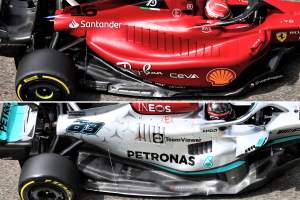Up Next

Mercedes has had a terrible start to the 2022 Formula 1 season by its own standards, which it has set over the previous eight years.
On a good day, it’s just about the third-best car, but the Emilia Romagna Grand Prix was its toughest weekend yet. It’s clear that progress isn’t being made with getting its porpoising problems under control.
There have been plenty of questions about what action it is going to take. Inevitably, there are questions about whether it effectively has to start again and scrap this car concept in favour of another.
Mercedes team principal Toto Wolff was robust in his defence of the concept of the W13 during the Imola weekend, but accepts something isn’t working – although still the focus is on trying to find the right operating window for the car.
That means running a lower ride height so the car produces the expected downforce, something the porpoising problem currently makes impossible.
“All of the goodness and badness happens mainly on the floor, as it stands at the moment,” said Wolff.
“We have interesting ideas and concepts that we are trying and that we are exploring that have to find its way onto the car in the next few races.
“There is no such thing as a concept being wrong, but is there a part of what we have done that just simply doesn’t work with the regulations? And what is it?
“You don’t need to throw away the goodness. You can keep the goodness but if there are fundamental areas that don’t allow us to unlock the potential that we believe is in the car, well, then obviously you need to cut your losses.”
You can get caught up in a problem where the car should fundamentally work, but it requires time to find that fix that means you can get it into that window.
However, the concept and working window go hand in hand and you can get into a situation where they are at odds with each other. That’s when you have to start questioning the whole concept, the assumptions and objectives that you used to design the car in the first place.
If you have continuity of the regulations, then your development direction for the following season is straightforward. You know where you were weak and where you were strong so you can focus on the relevant areas to make sure you reduce the weaknesses, but not at the expense of the strengths.
But you must avoid unnecessary risks in the areas that are circuit sensitive. The reintroduction of powerful ground effect floors, which always have and always will been very track sensitive, means there was always a risk. There are very few tools you can use to predict performance and behaviour before the car hits the circuit.
When grooved tyres were introduced in 1998, it became more difficult to follow the same path as in previous years. Williams, for example, won the ’97 world championship but in ’98 its performance fell off dramatically – and not only because of Renault pulling out.
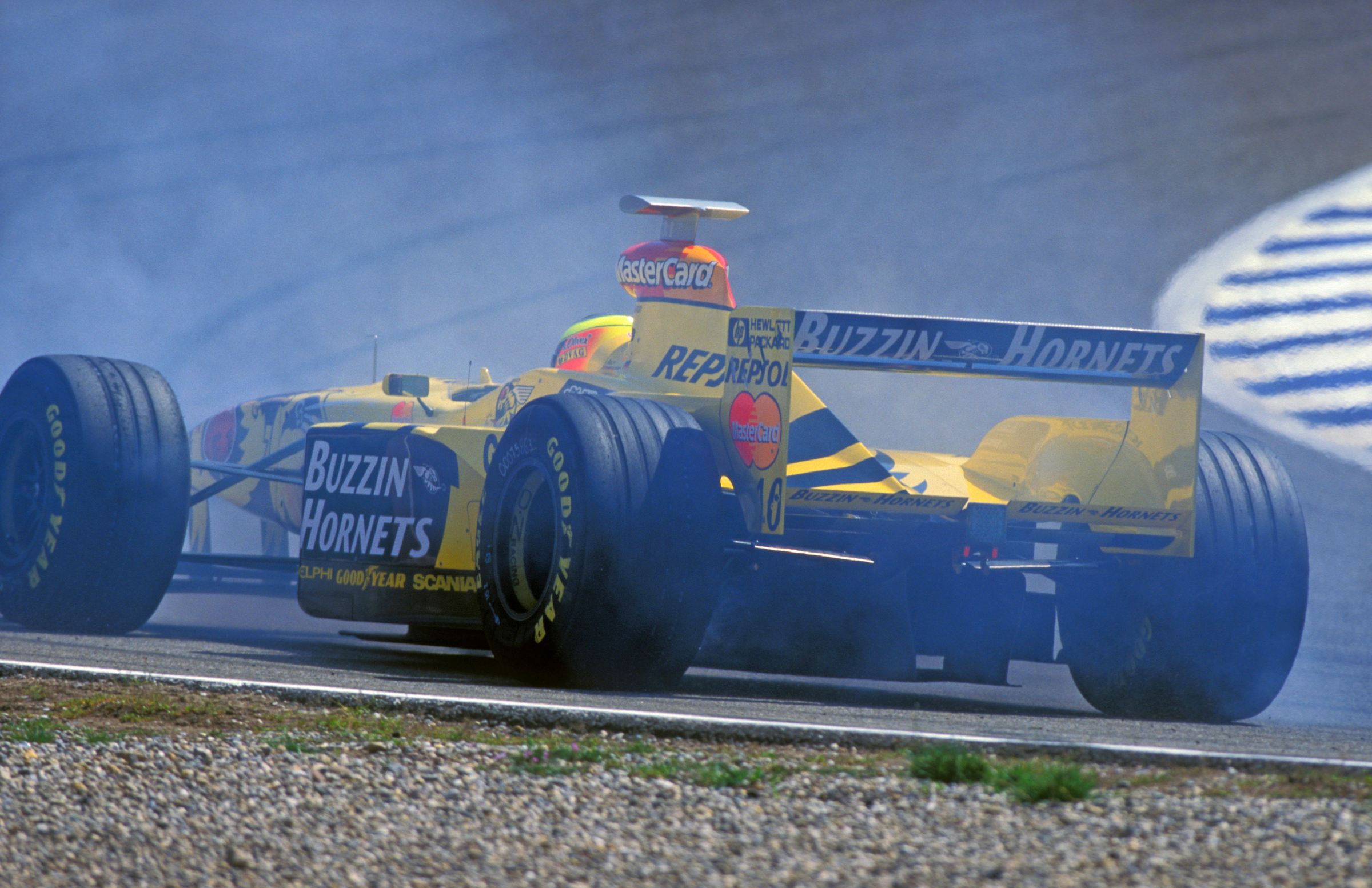
It was very similar for us at Jordan, where I was technical director, although we had to cope with changing to another engine supplier on top of that as Williams used the old Renault designs prepped by Mecachrome while we switched from Peugeot to Mugen Honda.
The grooved tyres changed everything. Not only did it mean there was less tyre in contact with the ground, but also the narrow sections of contact patch moved much more, basically if the tyre was overloaded it would walk across the track.
The reality was that you needed to physically test on track before you found out how they reacted to weight and aero distribution. That’s why 1998 was a season where many teams, including ourselves, worked a lot on wheelbase changes in an attempt to overcome these problems.
In the same way, the 2022 regulations have introduced new problems. The baseline has been dramatically shifted, with the overall aerodynamic concept prioritising underbody downforce.
No team expected porpoising to be a problem to the extent that it has been, and neither did the research group that set the new regulations. It all came as a surprise when the cars started to run in testing, with teams destroying floors within a few laps.
Every team has its own set of aerodynamic characteristic priorities used to set out the initial parameters for how they want the car to work. This will include an aero map centre of pressure shift generated from a sequence of ride height changes, at which ride heights they want the diffuser to stall to reduce drag, how the centre of pressure shifts during braking, with roll, with yaw and with varying steering lock.
No matter what the regulations throw at you, it’s necessary to stick to your basic principles that from past experience have served you well. You will then learn how the new regulations can be exploited to achieve some of these parameters perhaps in a different way.
The concept is the visual thing that you go about getting the best from. If you look at the Ferrari compared to the Mercedes, they are visually very different cars. Ferrari didn’t start with something that looked like a Mercedes and end up with what it has now and the same is true of Mercedes, it didn’t start with something that looked like a Ferrari and end up with the ‘zero sidepod’ solution.
So you commit yourself to something, which is what I call the concept. From there, you optimise it. If you were going to potentially try to achieve getting the best out of four or five different concepts, you would need 10 windtunnels and massive manpower.
You will identify the areas that the driver usually complains most about and try to influence that centre of pressure shift in the direction required to give the driver a better, more consistent balance through the braking process and corner-speed range that most circuits throw up at you.
If you haven’t got it right to begin with, then it’s back to the drawing board and another cycle of research to see if you can identify where the problems originate. If you can do that, you can usually instigate a set of changes that will rectify the situation.
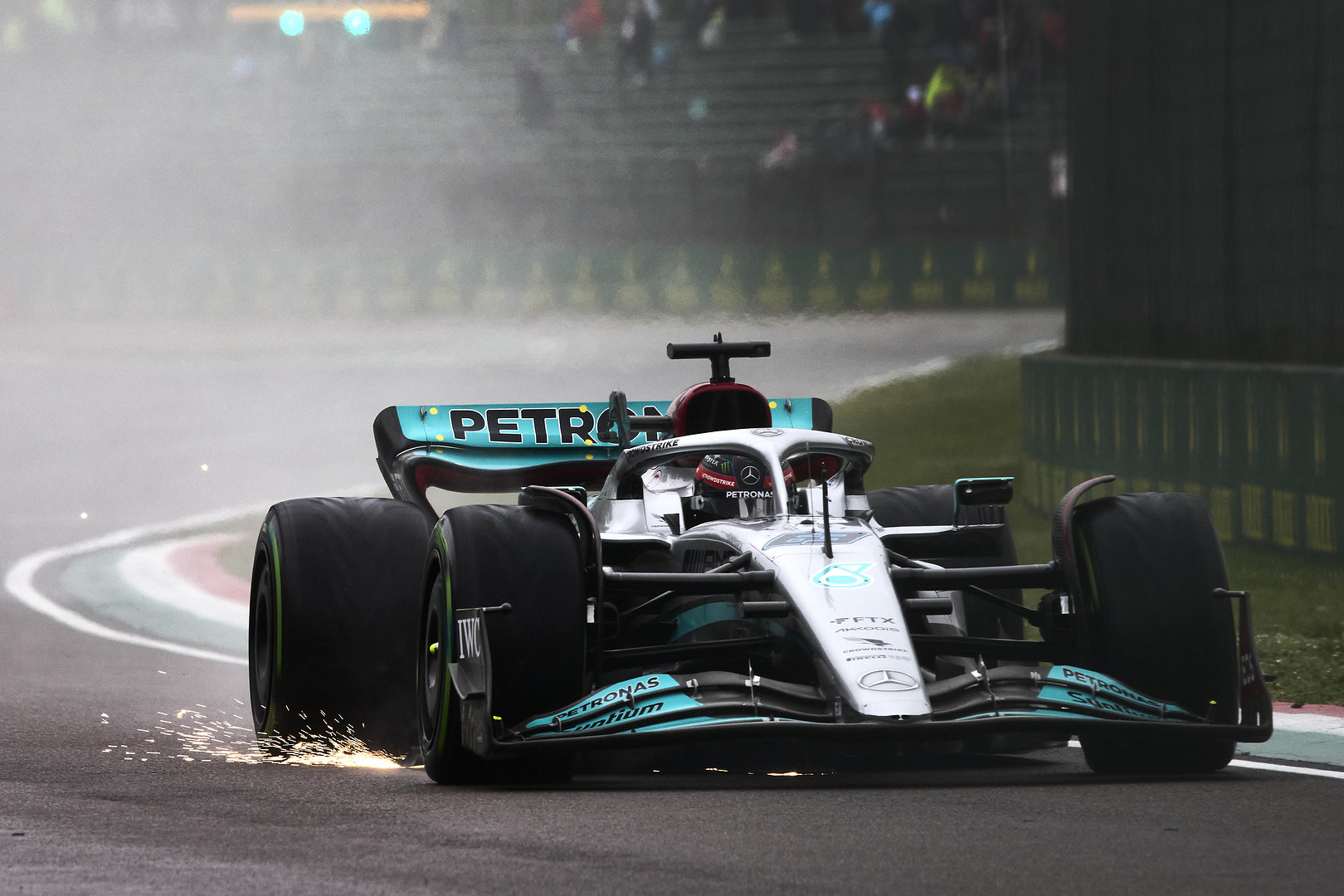
Mercedes seems to be struggling to identify where its problems are coming from. The proposing is clearly the visual problem, but that’s the symptom rather than its source so you can’t fix it unless you know exactly where and what is generating those problems.
When I first saw the ‘zero sidepod’ package, I thought Mercedes must be pretty confident in its research direction to go out on a limb and commit to such a different package with such limited pre-season testing.
It’s all about numbers. As you are evaluating your development direction, it’s the numbers that take you in a certain direction and help you make the big decisions. From what Mercedes ended up with, those numbers must have been heading in a positive direction but anything that is happening near the ground needs to be considered a risk when the car hits the track.
Guessing, I would say Mercedes was getting big downforce numbers with this zero sidepod design but at the expense of the car running close to the ground, which means that it will need to run very stiff. So you would say Mercedes forgot about all else in pursuit of aero load. You can’t just run the car solid and hope that the extra aero load will overcome all other negatives.
Remember, Mercedes threw away the initial three days of testing at Barcelona running a completely different aerodynamic package that, on face value, didn’t look too bad out on track. I was there and I wouldn’t say it suffered too dramatically from porpoising. Yes, there was some bouncing but it was the first test and it was the same for everyone.
Most teams have got on top of this porpoising to an acceptable degree, but it appears that Mercedes is struggling to identify where it is coming from. To combat it, Mercedes is simply raising the rear ride height of the car but that means too big a performance drop. Unexpectedly, the problem was worse at Imola and Mercedes had to raise the ride height even more than anticipated.
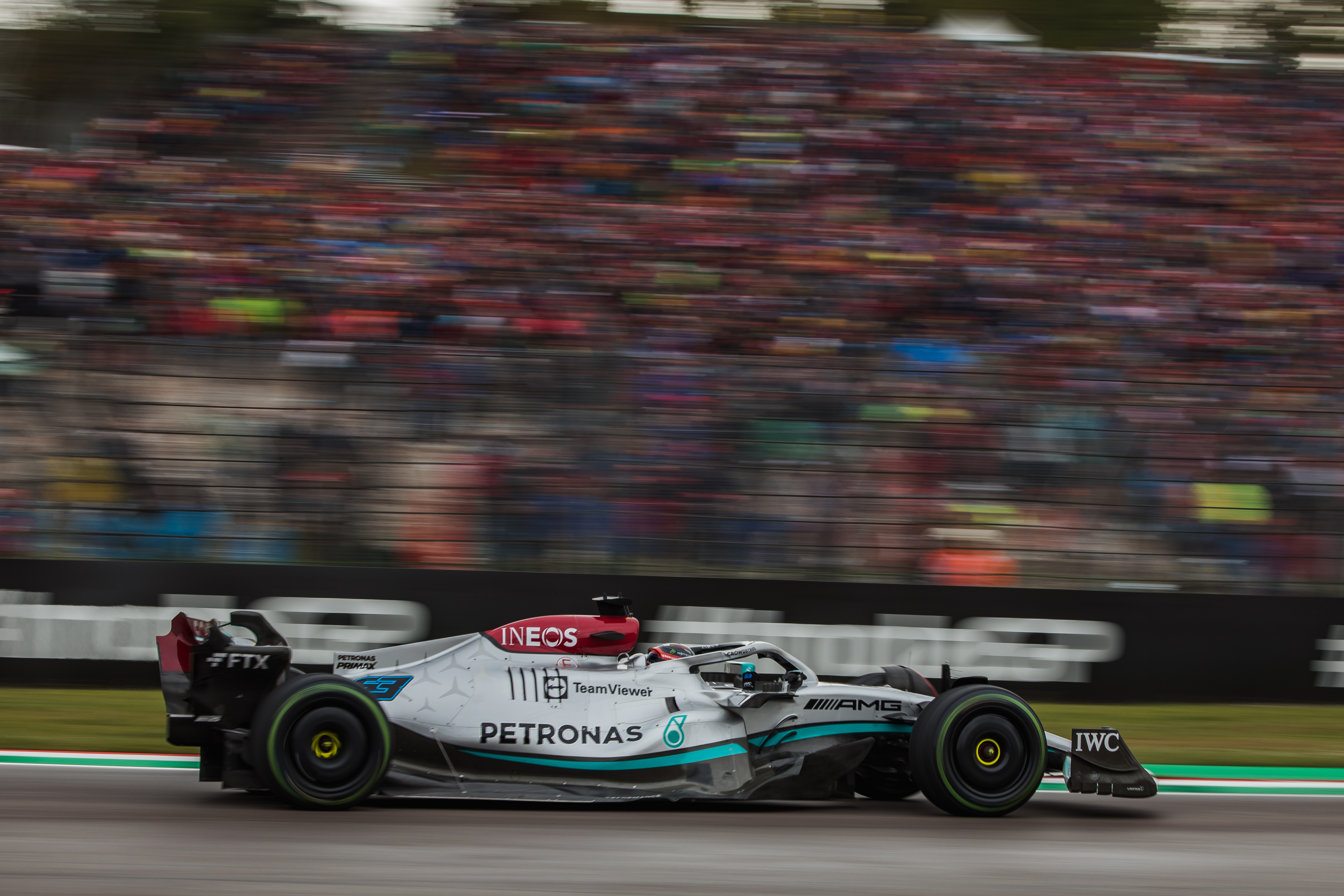
So how do you find the problem? Well, assuming the research for the sidepod concept and the research to identify its problems is conducted in the same windtunnel, perhaps it could be a problem either with the windtunnel itself or how it runs through its test cycle. It’s very easy for the ride height range that you use to generate your aero map not to relate to how the car operates on the circuit.
Also as we have seen, the ride heights that the teams are running on all the cars including Mercedes are lower now with the introduction of ground effect. This means that that aero map will be produced over a much smaller range, again leading the engineers to run the cars stiffer.
But there is only so much you can do. The loads, or more importantly the change in loads, still go through the tyres before it gets to the track surface. Stiffer suspension means the tyre works more and, in reality, there is very little damping in the tyre so when it starts bouncing it is much more difficult to stop it.
There will be many different ways to generate that aero map and many different ride heights, but the reduction in windtunnel run time might just have influenced the number of points that are used to generate that map.
Below is a very simple ride height range you would test in the windtunnel to produce an acceleration and braking map. F = front, R = rear (all in millimetres). At each of these heights, you will take a datum point.
So you would pick something like F25-R50, F20-R40, F15-R30, F10-R20, F5-R15 – now this is where it gets interesting – F4-R13, F3-R11.
Then, if you can keep the model stable enough, you would run F2-R9. From there, you might simulate braking, so keep the front at F2-R20, then F5-R30, F10-R40, F20-R50, F25-R50 and you are back to where you started from.
So that’s eight points accelerating and five braking, all of which could take at least one minute each to move the model to the new height, let the flow stabilise and take your data. There will be many more single ride height points, and that’s before you start to get trick with roll, yaw and steering aerodynamic characteristics.
Once you have these datum points, you can generate a speed increase/decrease aero profile for the car. But it’s never as simple as that.
In some windtunnels I have used, the control strategy for the model will return to a reference ride height between each datum point. This is just to make sure it hasn’t lost itself during all these individual height changes. When you consider that we are talking about a 60% scale model, those small numbers for belt clearance become even smaller.
If it does this procedure between each datum point then you never really understand how any underbody separation problems increase or recover.
Somewhere between F5-R15, I would expect problems to start to rear their ugly head in the underfloor area. You need the airflow separation to generate a drag reduction to improve top speed but it needs to be above the speed of the fastest demanding corner or more importantly below the ride height that the car is at through the fastest demanding corner.
That in itself is not a problem as you want a diffuser separation to reduce the drag but it’s the recovery of that separation that can be a major problem.
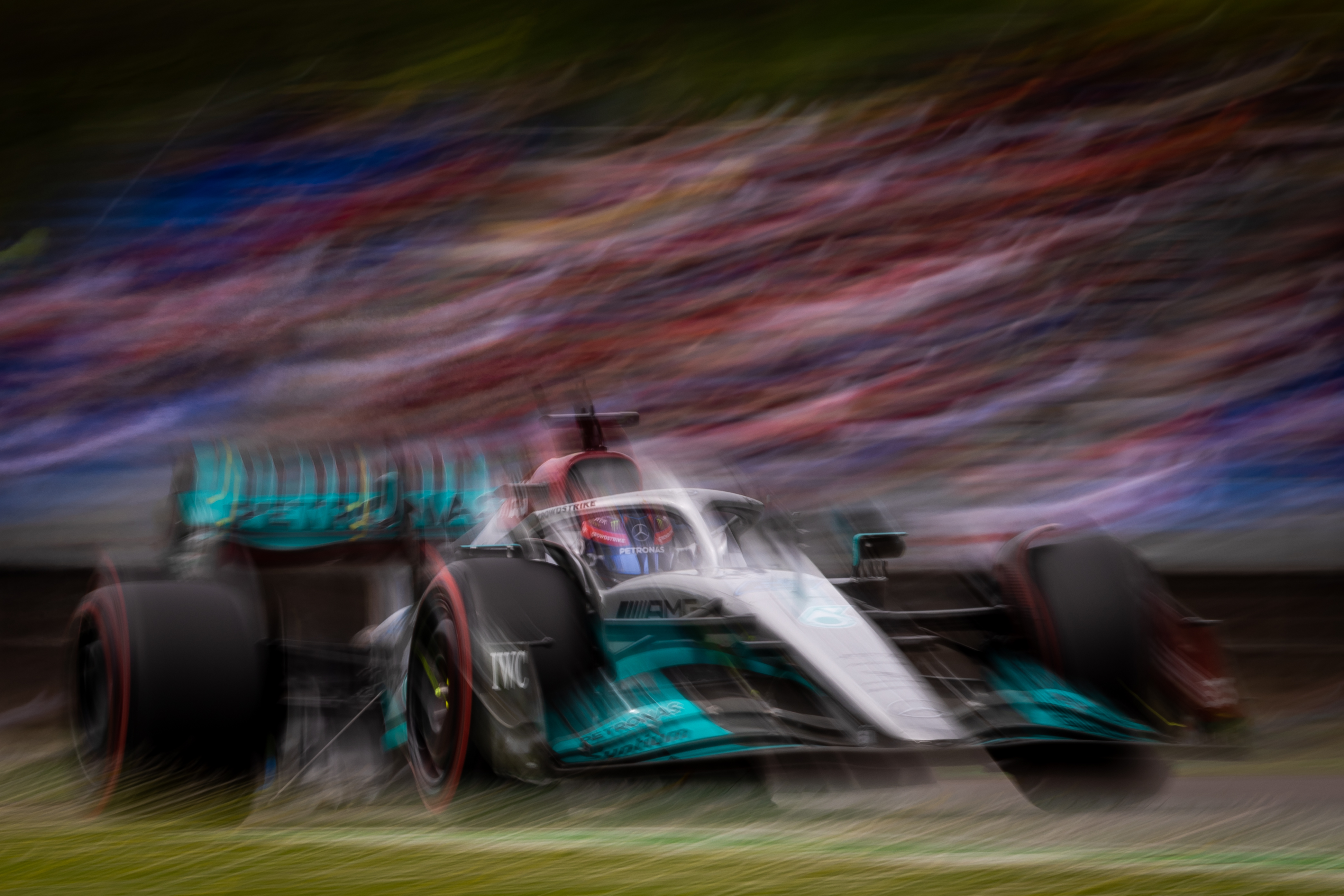
If, for example, you get down to F2-R9 and then go straight to F2-R20 and the loads are back to where you would expect them to be then it can all look fine.
However, that ride height change will have happened in less than a tenth of a second. A typical braking zone is less that one second and initially the car is travelling at something like 320km/h, or roughly 90m/s, that means that the car will have travelled nine metres in that tenth of a second, or two car lengths. It’s during that initial period of braking that the driver gets the confidence in the stability of the car, the commitment to corner entry is all based on that confidence.
Finding out when the diffuser airflow reattaches under braking is critical and it will also be crucial to understanding what the porpoising profile is like. If the diffuser reattaches instantly, which I doubt very much it will, that means the car will be stable under braking and any porpoising will be at a very high frequency. If it is slow to reattach, it will mean the car will be unstable under braking and the porpoising will be at a low frequency.
From what I see, Ferrari has low-frequency porpoising, whereas the Mercedes has high-frequency porpoising. But the cars’ stiffness will also play a big part in this visual porpoising. If it’s mainly the suspension moving it will be low frequency because the dampers will slow it down, if it’s mainly the tyres moving it will be a higher frequency as there is more or less no damping in the tyres. The Red Bull has very little of either.
If I was to set out to research this porpoising problem, I would first of all make sure that the model only travels in the direction of the requested ride height changes, no going back to a reference ride height between data points. I would also be concentrating on the lower ride heights to identify the underbody separation problem’s Hysteresis profile.
So F5-R15 to F4-R13 to F3-R11 to F2-R9 – identify at which of these ride heights you see a reduced load change that could be attributed to an underfloor separation problem.
If it was at, say F3-R11, then you would still go to F2-R9. The separation should still be there or even larger, then go to F2-R10.
If the load increases, then the separation has reduced – if not then go to F3-R10, then F3-R11. Continue in these 1mm steps, which is 0.6mm on the model – or even smaller – until the loads show that the separation has reattached.
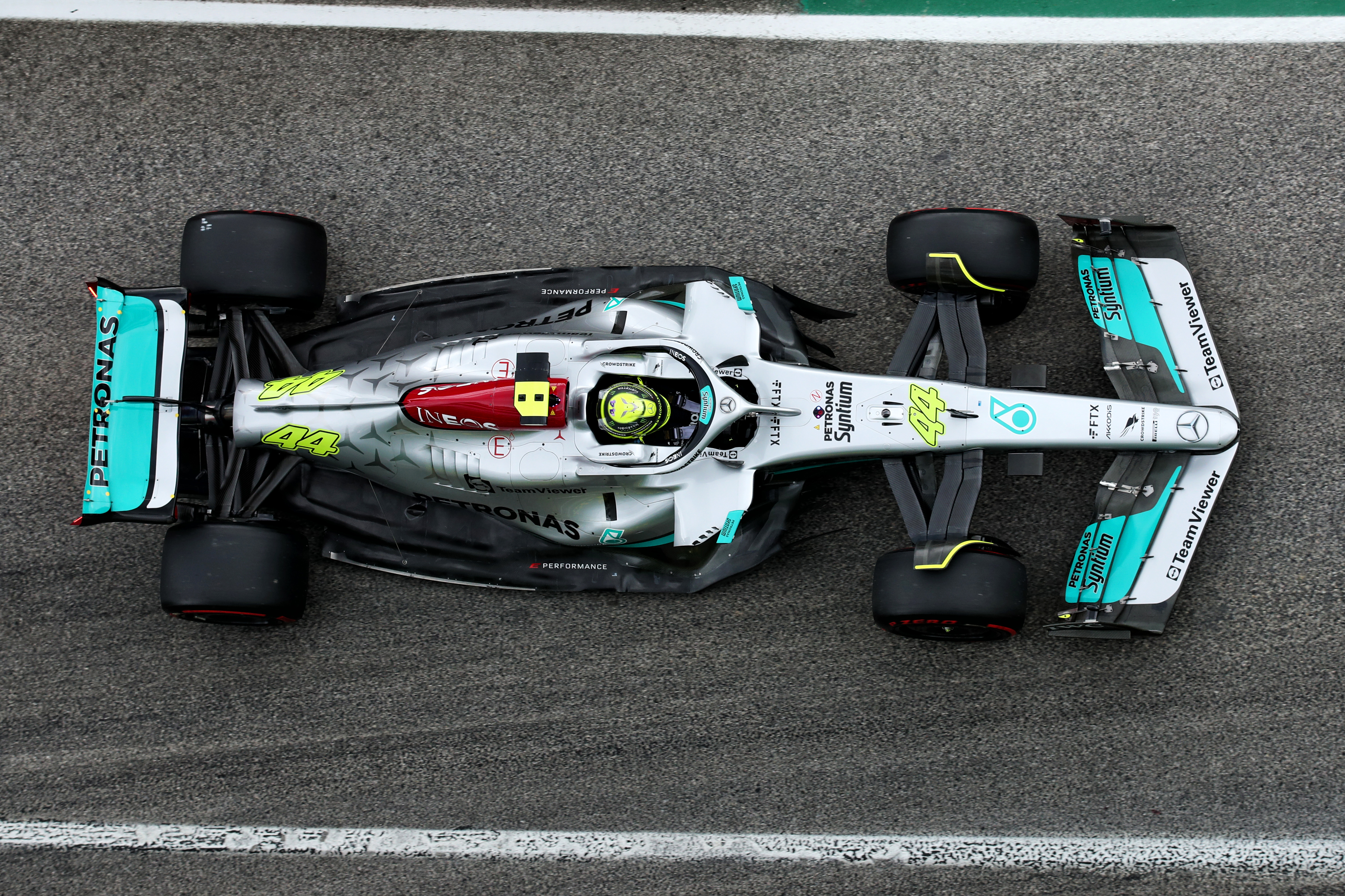
The centre of pressure change during this sequence should identify if the front or rear of the underfloor is the main culprit. Identify why and then go about finding a solution.
The main problem with underbody separation is that if it happens in the windtunnel. which is a very controlled environment, it will be much more severe on track. On track, the car is never stable – it is always moving vertically either because of the spring stiffness or the tyre stiffness.
This will take up very valuable windtunnel time when you could be just finding extra points of downforce. But sometimes you have to go backwards before you can go forwards.
The more aggressive you are with how you go about producing downforce from any aerodynamic surface, the more risk you are taking of it falling over when the working conditions change.
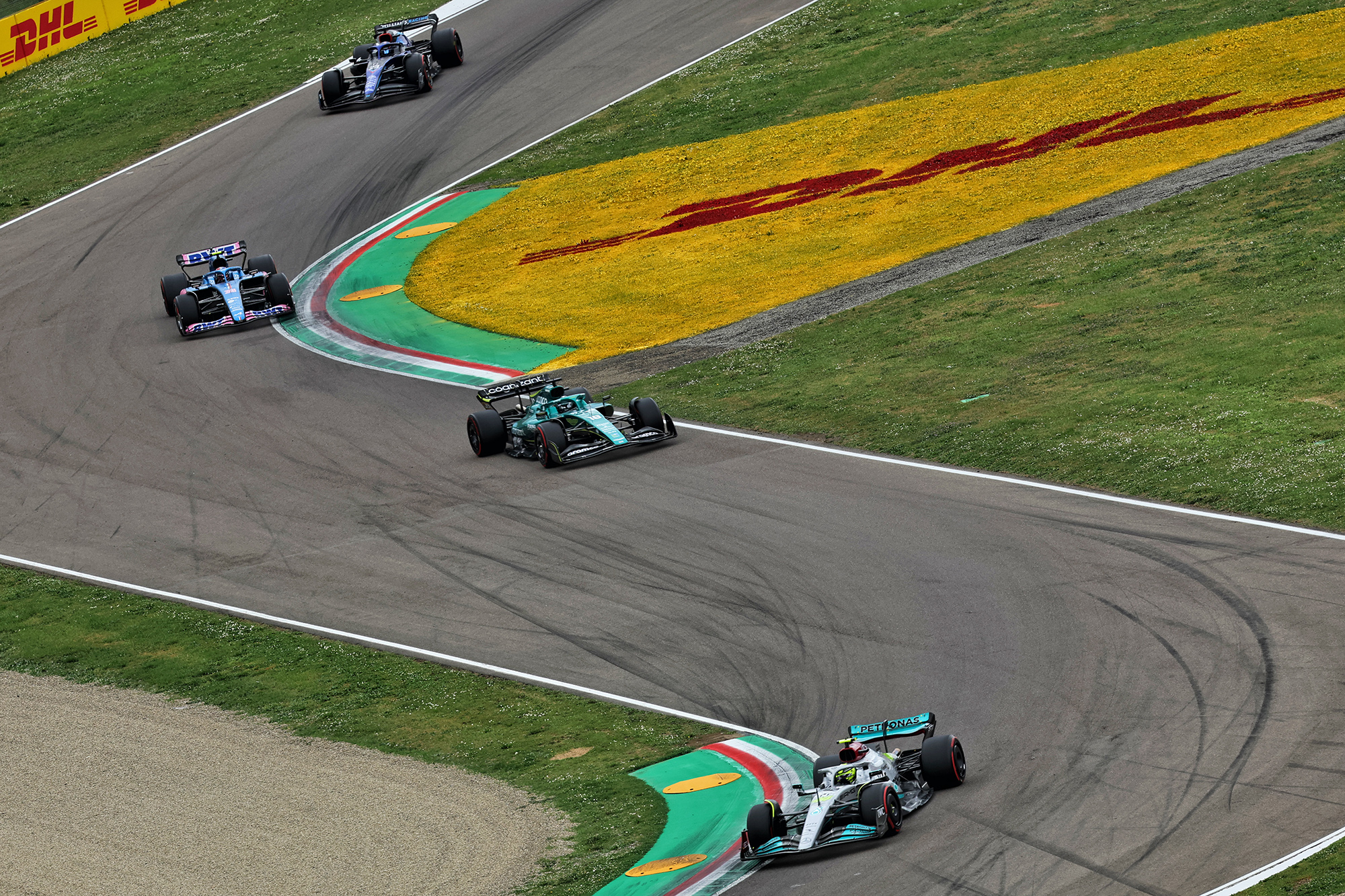
These cars are heavy enough, but relatively speaking the Mercedes looks a little better when it has a full fuel load. In qualifying with low fuel the car will weigh 805kg, at the start of the race with another 100kg of fuel added 905kg, so a weight increase of 13%
The extra weight means that the car weight will be a larger percentage of the change in aerodynamic load due to porpoising so in effect it will damp out some of the body accelerations offering a little more consistency to the ride height change and in turn visual porpoising.
I don’t think Mercedes needs to put the zero sidepod concept in the bin, but I would say that over the past few years when other teams were running high-rake cars, they all learned a lot about how to generate an aerodynamic seal along the sides of the floor.
Mercedes, with its low-rake concept, didn’t have to do that so its learning curve in this area is behind the others. And I think you can see this in the detail of the outer floor edge, which is still very primitive in its design.
I never like to see what should be a frontrunning team not achieve what it should be capable of. But four races in and I haven’t seen any impact being made by Mercedes on its problems
Has Mercedes given up on 2022? I doubt that very much, but it won’t be long before the championships are out of reach and that is when the team might just decide that it is better to bite the bullet and make sure that it has the maximum windtunnel time for next season.
But in order to do that, it still needs to understand what’s causing the problem. So even if Mercedes continues to struggle for results this year, what’s essential is that it builds that knowledge base to be able to feed into next year’s car.





